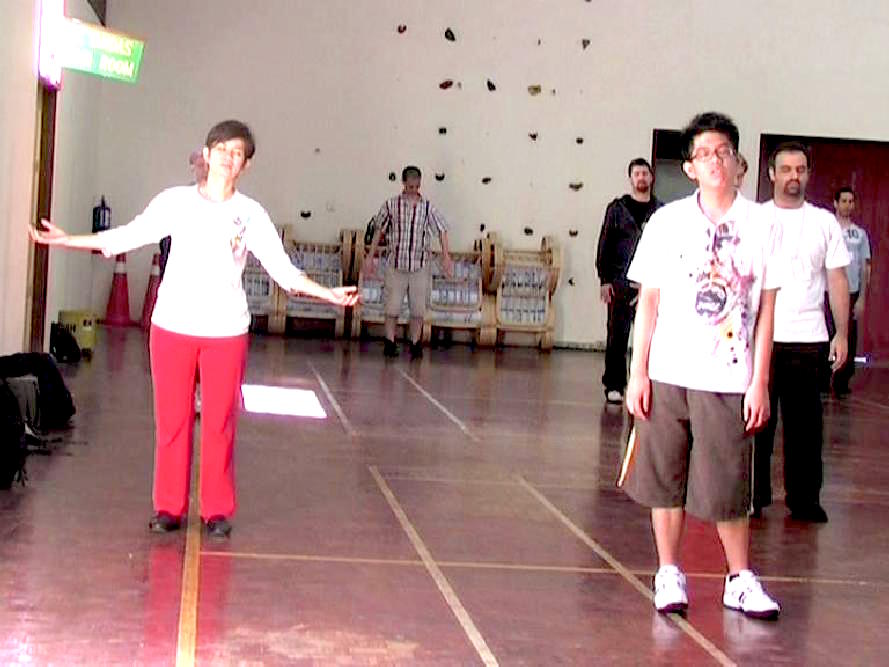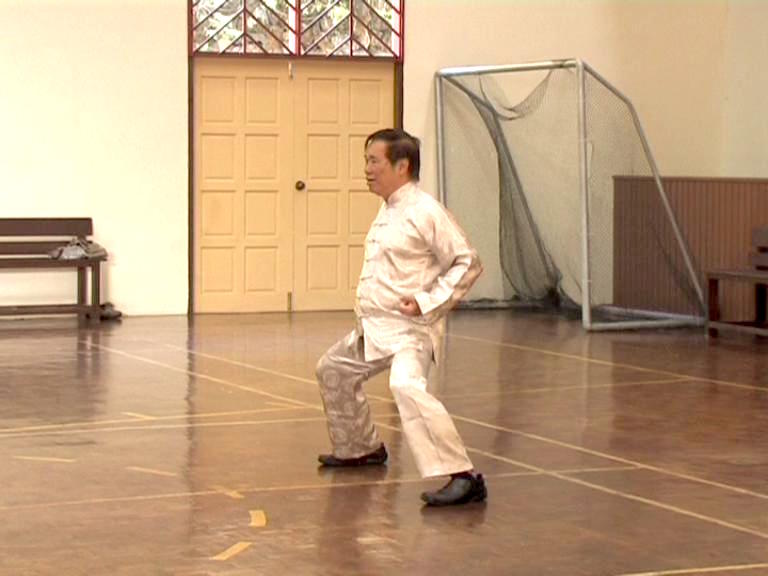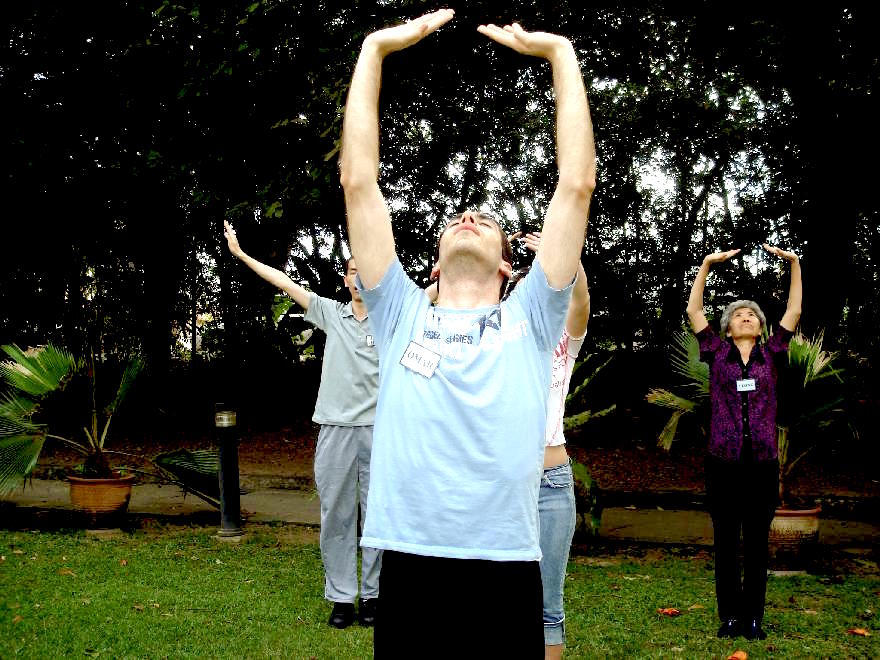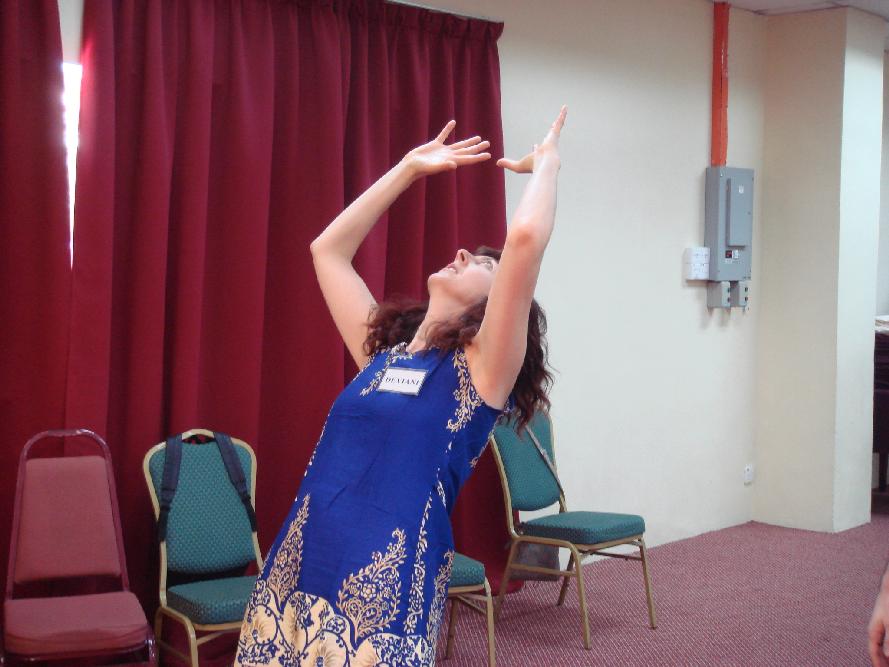SELECTION OF QUESTIONS AND ANSWERS
DECEMBER 2010 PART 3

Students at the Intensive Chi Kung Course in Sabah from 26th to 29th June 2010 enjoying a cosmic shower
Question 1
I have just bought Sifu Wong Kiew Kit's wonderful book, "Chi Kung for Health and Vitality", which is absolutely brilliant, and I am going to do home-study,
— Nathalie, UK
Answer
Thank you for your kind words for my book. While you can get good benefits by practicing from my book, the benefits you get will be immensely more if you learn personally from one of our Certified Instructors. If you attend my Intensive Chi Kung Course, it will even be better.
It is hard to imagine the difference. You may think that by learning personally from our instructors or from me, it will be two or even three times better. It is hard for you and many people to believe that by attending my Intensive Chi Kung Course, for example, the benefits can be more than a hundred times better. A main reason why many people cannot appreciate the difference is because they mistakenly think that if they know the techniques they will derive the benefits.
Question 2
But I just had one very important question. Is it true that visualization is no longer necessary in chi kung practice as it does not add benefit to the practice? A gentleman who is an instructor of Shaolin Chi Kung here in the UK has given me his opinion that visualization is no longer necessary, and I am sure he is right, but I just wanted to seek your opinion.
Answer
Actually this is not an important question. But I shall give you an in-depth answer.
No, it is not true that visualization does not add to the benefits of chi kung. In fact, in many types of advanced chi kung, visualization is essential. Without visualization the result will be low-level even though the exercises themselves are advanced. However, this does not necessarily mean that there is no high-level chi kung without visualization.
An example is Cosmic Shower, which is one of many advanced exercises taught in my Intensive Chi Kung Course. It is by performing appropriate visualization that students tap energy from the Cosmos to have a cosmic shower, which clears away their energy and mental blockages, and strengthen them physically, emotionally, mentally and spiritually. If they just perform the exercise without visualization, they may just have an energy flow.
Whether visualization is necessary depends on various factors. In your case where you learn from books, for example, it is best to leave out visualization. It is because not only you will not derive benefits from the visualization, but more significantly you may harm yourself seriously.
How can you harm yourself if you follow the instructions in the book about visualization? It is not the techniques which the instructions describe, but the skills with which you perform the techniques that are important. But aren't the skills described in the book too? The skills are generally not described; they have to be developed. But even if the skills are described, you will be unable to perform them.
Let us take an example from Cosmic Shower. One important instruction is as follows. Open your bai-hui (which is a vital point at the crown of your head), and let good cosmic energy flow into you. Even when you understand this instruction very well, you will be unable to carry out this skill. You have to learn it personally from a master.
An analogy may make this clearer. Suppose you wish to learn to play football by reading a good football manual. An instruction to help you score goals is as follows. Dribble the ball past the defenders and shoot it to the left bottom corner of the goal-mouth. Even when you understand the instruction clearly, you will be unable to carry out this skill.
Isn't it unfair that you have to be contented with low-level results practicing from a book, while those who attend my Intensive Chi Kung Course have high-level results, you may ask. You have to be reasonable. They pay 1000 euros to attend my course to learn high-level skills, whereas you pay much less for purchase of the book.

Stance training when practiced correctly can be full of benefits and subtle joys
Question 3
I searched for the best way to cultivate chi by reading some books and resources, and found Zhan Zhuang to be particularly interesting as it helps to cultivate chi, nourish internal organs and improve health without the requirement to do any movement or pattern.
— Heng Cheong, Malaysia
Answer
Many people find zhan zhuang, or stance training, not only boring but very demanding because they have to endure remaining at one position for some time. However, we in Shaolin Wahnam find zhan zhuang both enjoyable and beneficial.
Why is there such opposing difference? Some people may not like what we say, but it is true. Many people practice zhan zhuang as an endurance test and derive no benefits, but we practice is as a relaxation exercise and derive a lot of benefits.
Question 4
However, I read your article on the horse stance and learned that this stance training should be done with care to derive the benefits or else there would be severe harm. So I need to know how to practice the horse stance correctly.
Answer
This is very true. If you practice the horse stance wrongly, you will have much energy blockage. If you practice it correctly, you will have much internal force and mental clarity.
The answer to your question as to how to practice the horse stance correctly is very simple, though it may not be easy. There are actually two answers, an academic answer and a practical answer.
The academic answer consists of two steps. One, get the form correct. Two, follow the three golden rules of stance training, i.e. relax, relax and relax.
The practical answer is straight-forward. Learn it personally from a master who knows how to practice the horse stance correctly and who is willing to teach you.
I would like to add that you should not just learn from any masters. Some masters discard the horse stance and favour bouncing about. Some masters suffer from back pain and knee injuries. You are unlikely to get much benefit of the horse stance from these masters. On the other hand, some masters are very good at the horse stance, but they may not want to teach you.

Lifting the Sky
Question 5
Can you provide me the complete details? I don't mind if it is troublesome. I just want to do the training as correctly as possible and leave no chance to error
Answer
You can read the details of how to perform the horse stance from my Shaolin or Taijiquan books, or from any good kungfu books. You can also see how it is performed from videos in my website, or from videos of any good kungfu practitioners demonstrating the horse stance.
Even if you know the detailed instructions, you may not be able to carry them out. For example, two very important instructions are to keep your body upright and to be relaxed. But many people lean back and most people tense their muscles even when they know the instructions. It is precisely for this reason, i.e. students may not be able to carry out the instructions correctly even when they want to, that you should learn stance training from a competent teacher.
Question 6
What are "Lifting the Sky" and "Carrying the Moon" in qigong training? How to practice them with zhan zhuang? Can you provide me with the details?
Answer
"Lifting the Sky" and "Carrying the Moon" are two excellent chi kung exercises taught in our school. They have brought many wonderful benefits, like good health, vitality and longevity, to our students.
You can practice one or both of them before or after practicing zhan zhuang, or separately from zhan zhuang. You can read up the details of how to practice them from my chi kung books.

Carrying the Moon
Question 7
Can I cross my arms while doing zhan zhuang?
Answer
You can but you may not.
This means if you want to cross your arms while practicing zhan zhuang, you can do so. No one is going to stop you except yourself even if you have a strict teacher who may hit you with a cane.
But it is not advisable for you to do so. You would get the best benefit by following the instructions required for that particular stance training. If you perform the Horse-Riding Stance, for example, you should place your two fists at your sides at waist level.
If you perform the Three-Circle Stance, you should hold your arms like holding a circle in front of your chest. If you cross your arms, you may not have adverse effect, but you will not get the best benefit.
Question 8
What are the differences between Taoist breathing and Buddhist breathing? I know that the difference is in the inhale/exhale part where the abdomen either expands or compresses in, but what other difference is there in terms of health and effect? Can either one be used for zhan zhuang?
Answer
Your concept is mistaken. Both Taoist and Buddhist breathing may have the abdomen expand or compress when practitioners inhale or exhale.
In Abdominal Breathing, for example, the abdomen expands when practitioners inhale, and the abdomen compresses when they exhale. In Reversed Breathing, the abdomen compresses when practitioners inhale, and the abdomen expands when they exhale.
But it is important to note that it is energy and not air that flows into the abdomen. This means that expansion and compression of the abdoment may not be clearly noticable. In fact if the expansion and compression of the abdoment are drastic, as is often the case with those who learn from books or incompetent instructors, it is an indication that they are practicing incorrectly. They perform mechanical breathing exercise rather than chi kung.
Abdominal Breathing and Reverse Breathing are frequently practiced in chi kung of the Taoist tradition. Hence they are often regarded as Taoist breathing. This does not mean that the expansion and compression of the abdomen do not occur in chi kung of the Buddhist tradition.
In Taoist chi kung, the expansion and compression of the abdomen is employed as techniques to regulate breathing. But in Buddhist chi kung, while breathing may be involved, practitioners do not pay particular attention to the expansion and compression of the abdomen. In Taoist chi kung the focus is more on energy, whereas in Buddhist chi kung the focus is more on mind.
Yes, either Taoist breathing or Buddhist breathing can be used in zhan zhuang. When practicing zhan zhuang you may consciously regulate your breathing, which is akin to Taoist breathing, or you may just forget about your breathing, which is akin to Buddhist breathing. If you consciously regulate your breathing, your abdomen may expand or compress when you inhale or exhale.
I recommend that you don't worry about your breathing when practicing zhan zhuang. This means you let your breathing to be spontaneous. Even in Taijiquan, Baguazhang and Xingyiquan, which are often questionably regarded as Taoist arts, there is usually no specific instruction on the expansion and compression of the abdomen during breathing while performing zhan zhuang.
LINKS
Selected Reading
- An Incredible Experience
- We Experience a Kind of Miracle when We Came Back
- Why did Kungfu Masters in the Past Fight the Way They Fought?
- Praying Mantis Kungfu is Famous for Kicks
- How to Deal with a Boxer Bouncing Around
